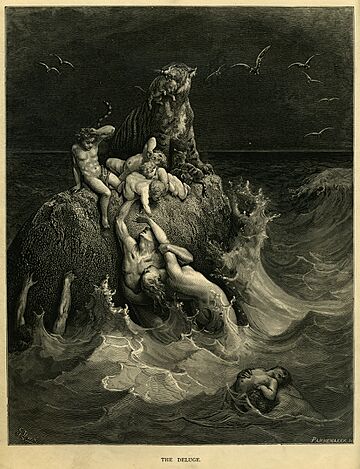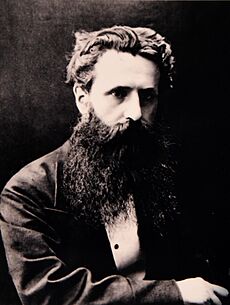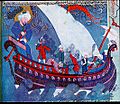Flood myth facts for kids
A flood myth is a story about a huge flood. This flood usually covers the whole world. Often, a god or gods send the flood to destroy civilization. This happens because people have done something wrong. These stories often talk about the flood waters cleaning the world. This prepares it for a new beginning. Many flood myths also feature a hero. This hero shows humanity's strong desire to survive.
Stories about great floods exist in many cultures. You can find them in Hinduism, Greek mythology, and the Bible. There are also stories from Mesopotamia and the Cheyenne tribe.
Contents
Famous Flood Stories
The Epic of Gilgamesh
One of the oldest flood myths is in the Epic of Gilgamesh. This story comes from ancient Mesopotamia. Many experts think it was copied from an even older story called Atra-Hasis. This older story is from around 1800 BCE.
In the Gilgamesh flood story, the main god, Enlil, decides to destroy the world. He is angry because humans are too noisy. But another god, Ea, had created humans. Ea secretly warns a hero named Utnapishtim about the coming flood. Ea gives Utnapishtim detailed instructions to build a huge boat. This boat will help life survive.
Both the Epic of Gilgamesh and Atra-Hasis are similar to the Eridu Genesis. This is the oldest known flood story. It dates back to around 1600 BCE. Tablets with this story were found in ancient Nippur.
Some scholars, like Yi Samuel Chen, have studied these old texts. They believe the flood story was added to Mesopotamian writings later. For example, the part about the flood in the Sumerian King List seems to be a later addition. It was probably added during the Old Babylonian Period. This shows that the idea of a great flood changing history was a new concept back then.
The Genesis Flood Story
In the Hebrew Genesis, the god Yahweh decides to flood the Earth. He is sad because people have become very bad. Yahweh then tells a man named Noah to build a large ark. This ark will save human and animal life.
When the ark is finished, Noah, his family, and many animals enter it. The flood begins, and everything outside the ark dies. After the water goes down, everyone on the ark leaves. Yahweh promises Noah that he will never flood the Earth again. A rainbow appears as a sign of this promise.
Hindu Mythology
In Hindu mythology, ancient texts like the Satapatha Brahmana (around 6th century BCE) tell a flood story. It's called "manvantara-sandhya". In this story, the Matsya Avatar (a form) of the god Vishnu warns the first man, Manu. Vishnu tells Manu about the coming flood. He also tells Manu to build a giant boat.
Other Flood Myths
- In Zoroastrian Mazdaism, a bad spirit named Ahriman tries to destroy the world with a drought. The god Mithra ends this by shooting an arrow into a rock. This causes a flood. One man survives in an ark with his animals.
- The Greek philosopher Plato wrote about a flood myth in his book Timaeus (around 360 BCE). In this story, the Bronze Age humans make the god Zeus angry with their constant fighting. Zeus decides to punish them with a flood. The Titan Prometheus warns Deucalion. Prometheus tells him to build an ark to be saved. After nine days and nights, the water goes down. The ark lands on a mountain.
- The Cheyenne tribe in North America also has a flood story. They believe a flood changed their history. This might have happened in the Missouri River Valley.
Are Flood Myths True Stories?
Many people wonder if these flood myths are based on real events. Scientists and archaeologists have different ideas.
Ancient Floods
Some experts think that huge floods after the Last Glacial Period (about 11,700 years ago) might have inspired these myths. For example, Plato's story of Atlantis is set over 9,000 years before his time. Some scholars suggest that a Stone Age society near the Mediterranean Sea could have been wiped out by rising sea level. This event might have become the basis for the Atlantis story.
Archaeologist Bruce Masse believes some flood stories might be linked to an asteroid hitting the ocean. This could have happened between Africa and Antarctica. It would have caused a giant tsunami. He studied 175 flood myths. He found that some mentioned a special alignment of planets or a solar eclipse. Masse suggests a meteor or comet might have hit the Indian Ocean around 3000–2800 BCE. This could have created the Burckle Crater and caused a huge tsunami.
Mesopotamian Floods
Mesopotamia was a land with many rivers. It often had floods. For people living there, a big flood could destroy their whole world. At the ancient city of Shuruppak, archaeologists found a layer of sand and clay. This layer suggests a flood happened around 2900 BCE. In Mesopotamian legends, Shuruppak was the city of Uta-napishtim, the king who built a boat to survive the flood.
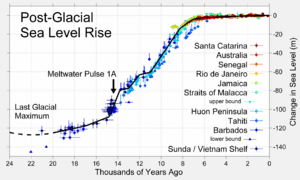
The area of Mesopotamia changed a lot after the last ice age. The Persian Gulf filled up as sea levels rose. Global sea levels were much lower about 18,000 years ago. They rose until about 8,000 years ago. The Persian Gulf used to be a huge, fertile region. Many people lived there for thousands of years. Then, around 7,500 years ago, there was a sudden increase in settlements above the current sea level.
Mediterranean Floods
Historian Adrienne Mayor thinks that flood stories might have come from people finding seashells and fish fossils in mountains. Ancient Greeks, Egyptians, and Romans all wrote about finding these. The Greeks thought Earth had been covered by water many times. They used the fossils as proof.
Some people think the Greek flood myth of Deucalion might be based on a real tsunami. This tsunami could have been caused by the Thera eruption (around 1630–1600 BCE). This tsunami hit the South Aegean Sea and Crete. However, it did not affect cities in mainland Greece. This suggests it was a local event, not a region-wide flood.
Black Sea Flood Idea
The Black Sea deluge hypothesis is a debated idea. It suggests a huge amount of water flowed from the Mediterranean Sea into the Black Sea basin. This might have happened around 5600 BCE. This idea has caused a lot of discussion among scientists.
Comets and Floods
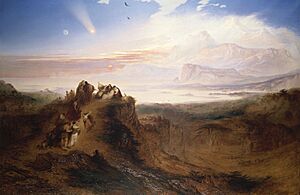
One of the first ideas about a comet causing a worldwide flood came from Edmond Halley in 1694. He suggested that a comet passing close to Earth caused the flood in the Bible. William Whiston, a follower of Isaac Newton, wrote a book in 1696. He argued that a comet caused Noah's Biblical Flood.
Later, in 1796, Pierre-Simon Laplace wrote about comets. He said that a comet hitting Earth could cause a "universal deluge." It could drown most people and animals. It could also destroy cities.
In 1883, Ignatius L. Donnelly wrote a popular book called Ragnarok: The Age of Fire and Gravel. He suggested a huge comet hit Earth around 6,000 to 9,000 BCE. He thought this event destroyed an advanced civilization on the "lost continent" of Atlantis. Donnelly also linked this event to the Biblical Flood. He believed it caused huge fires and changes in the climate.
Art
-
The Deluge, painted by Francis Danby in 1840.
See also
 In Spanish: Diluvio universal para niños
In Spanish: Diluvio universal para niños
- List of flood myths
- Sea level rise


